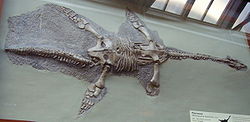Thalassiodracon hawkinsii
|
Thalassiodracon Temporal range: Rhaetian - Hettangian |
|
|---|---|
 |
|
| Thalassiodracon hawkinsi found in the Lower Lias strata, Street, Somerset, England. | |
| Scientific classification | |
| Kingdom: | Animalia |
| Phylum: | Chordata |
| Class: | Sauropsida |
| Superorder: | Sauropterygia |
| Order: | Plesiosauria |
| Suborder: | Pliosauroidea |
| Genus: |
Thalassiodracon Storrs & Taylor 1996 |
| Binomial name | |
|
Thalassiodracon hawkinsi (Owen, 1838) |
|
Thalassiodracon (tha-LAS-ee-o-DRAY-kon) is an extinct genus of small pliosaurs. The type and only species, is Thalassiodracon hawkinsi Owen 1840.
This marine reptile measured 1.5–2 m. (5-6.5 ft) had a relatively long neck but the small skull was proportionally larger than Plesiosaurus, being 1/10 of the total body length.
The neck of Talassiodracon, however, was slightly shorter than that of subsequent Plesiosaurs.The cervical vertebrae were between 27 and 31, while those of Plesiosaurus were 35 - 37. Moreover, the skull was unusually short and equipped with long teeth. The orbits were very large, with sclerotic rings. Like all plesiosaurs, this animal had legs like paddles for swimming in the sea.
A computed tomography of an exceptionally preserved skull, and examination of other specimens (Benson et al., 2011) yields new anatomical data. Thalassiodracon had a dorsomedian ridge on the premaxilla, a squamosal bulb, four premaxillary teeth, and a heterodont maxillary dentition.
These animals are known from a number of complete skeletons (Holotype: BMNH 2018) found by the fossil collector Thomas Hawkins in Somerset, England. They lived in the Late Triassic (Rhaetian) to the Early Jurassic (Hettangian) of Europe (age range: 201.6 to 196.5 million years ago).
The genus name Thalassiodracon means "sea dragon", while the species name hawkinsi honours its discoverer.
Thalassiodracon was originally placed in the genus Plesiosaurus. It has been classified in a new genus Thalassiodracon many years later following an examination of a skull. This animal is considered one of the oldest representatives of the group of plesiosaurs, perhaps ancestral to the superfamily of Pliosauroidea (short-necked plesiosaurs).
The following cladogram follows an analysis by Ketchum & Benson, 2011.
...
Wikipedia
